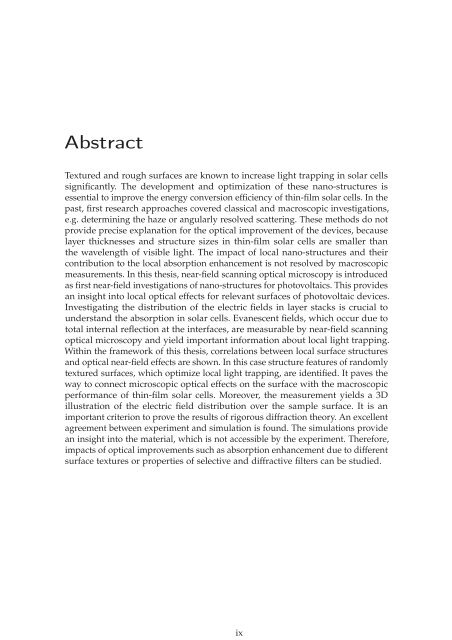View/Open - JUWEL - Forschungszentrum Jülich
View/Open - JUWEL - Forschungszentrum Jülich
View/Open - JUWEL - Forschungszentrum Jülich
Erfolgreiche ePaper selbst erstellen
Machen Sie aus Ihren PDF Publikationen ein blätterbares Flipbook mit unserer einzigartigen Google optimierten e-Paper Software.
Abstract<br />
Textured and rough surfaces are known to increase light trapping in solar cells<br />
significantly. The development and optimization of these nano-structures is<br />
essential to improve the energy conversion efficiency of thin-film solar cells. In the<br />
past, first research approaches covered classical and macroscopic investigations,<br />
e.g. determining the haze or angularly resolved scattering. These methods do not<br />
provide precise explanation for the optical improvement of the devices, because<br />
layer thicknesses and structure sizes in thin-film solar cells are smaller than<br />
the wavelength of visible light. The impact of local nano-structures and their<br />
contribution to the local absorption enhancement is not resolved by macroscopic<br />
measurements. In this thesis, near-field scanning optical microscopy is introduced<br />
as first near-field investigations of nano-structures for photovoltaics. This provides<br />
an insight into local optical effects for relevant surfaces of photovoltaic devices.<br />
Investigating the distribution of the electric fields in layer stacks is crucial to<br />
understand the absorption in solar cells. Evanescent fields, which occur due to<br />
total internal reflection at the interfaces, are measurable by near-field scanning<br />
optical microscopy and yield important information about local light trapping.<br />
Within the framework of this thesis, correlations between local surface structures<br />
and optical near-field effects are shown. In this case structure features of randomly<br />
textured surfaces, which optimize local light trapping, are identified. It paves the<br />
way to connect microscopic optical effects on the surface with the macroscopic<br />
performance of thin-film solar cells. Moreover, the measurement yields a 3D<br />
illustration of the electric field distribution over the sample surface. It is an<br />
important criterion to prove the results of rigorous diffraction theory. An excellent<br />
agreement between experiment and simulation is found. The simulations provide<br />
an insight into the material, which is not accessible by the experiment. Therefore,<br />
impacts of optical improvements such as absorption enhancement due to different<br />
surface textures or properties of selective and diffractive filters can be studied.<br />
ix

















